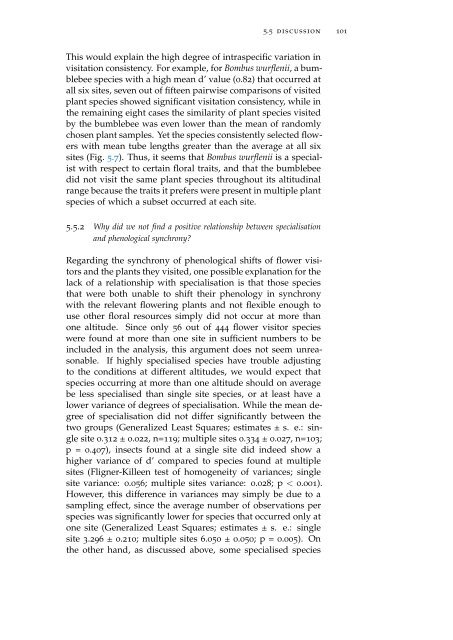Linking Specialisation and Stability of Plant ... - OPUS Würzburg
Linking Specialisation and Stability of Plant ... - OPUS Würzburg
Linking Specialisation and Stability of Plant ... - OPUS Würzburg
Create successful ePaper yourself
Turn your PDF publications into a flip-book with our unique Google optimized e-Paper software.
5.5 discussion 101<br />
This would explain the high degree <strong>of</strong> intraspecific variation in<br />
visitation consistency. For example, for Bombus wurflenii, a bumblebee<br />
species with a high mean d’ value (0.82) that occurred at<br />
all six sites, seven out <strong>of</strong> fifteen pairwise comparisons <strong>of</strong> visited<br />
plant species showed significant visitation consistency, while in<br />
the remaining eight cases the similarity <strong>of</strong> plant species visited<br />
by the bumblebee was even lower than the mean <strong>of</strong> r<strong>and</strong>omly<br />
chosen plant samples. Yet the species consistently selected flowers<br />
with mean tube lengths greater than the average at all six<br />
sites (Fig. 5.7). Thus, it seems that Bombus wurflenii is a specialist<br />
with respect to certain floral traits, <strong>and</strong> that the bumblebee<br />
did not visit the same plant species throughout its altitudinal<br />
range because the traits it prefers were present in multiple plant<br />
species <strong>of</strong> which a subset occurred at each site.<br />
5.5.2 Why did we not find a positive relationship between specialisation<br />
<strong>and</strong> phenological synchrony?<br />
Regarding the synchrony <strong>of</strong> phenological shifts <strong>of</strong> flower visitors<br />
<strong>and</strong> the plants they visited, one possible explanation for the<br />
lack <strong>of</strong> a relationship with specialisation is that those species<br />
that were both unable to shift their phenology in synchrony<br />
with the relevant flowering plants <strong>and</strong> not flexible enough to<br />
use other floral resources simply did not occur at more than<br />
one altitude. Since only 56 out <strong>of</strong> 444 flower visitor species<br />
were found at more than one site in sufficient numbers to be<br />
included in the analysis, this argument does not seem unreasonable.<br />
If highly specialised species have trouble adjusting<br />
to the conditions at different altitudes, we would expect that<br />
species occurring at more than one altitude should on average<br />
be less specialised than single site species, or at least have a<br />
lower variance <strong>of</strong> degrees <strong>of</strong> specialisation. While the mean degree<br />
<strong>of</strong> specialisation did not differ significantly between the<br />
two groups (Generalized Least Squares; estimates ± s. e.: single<br />
site 0.312 ± 0.022, n=119; multiple sites 0.334 ± 0.027, n=103;<br />
p = 0.407), insects found at a single site did indeed show a<br />
higher variance <strong>of</strong> d’ compared to species found at multiple<br />
sites (Fligner-Killeen test <strong>of</strong> homogeneity <strong>of</strong> variances; single<br />
site variance: 0.056; multiple sites variance: 0.028; p < 0.001).<br />
However, this difference in variances may simply be due to a<br />
sampling effect, since the average number <strong>of</strong> observations per<br />
species was significantly lower for species that occurred only at<br />
one site (Generalized Least Squares; estimates ± s. e.: single<br />
site 3.296 ± 0.210; multiple sites 6.050 ± 0.050; p = 0.005). On<br />
the other h<strong>and</strong>, as discussed above, some specialised species
















